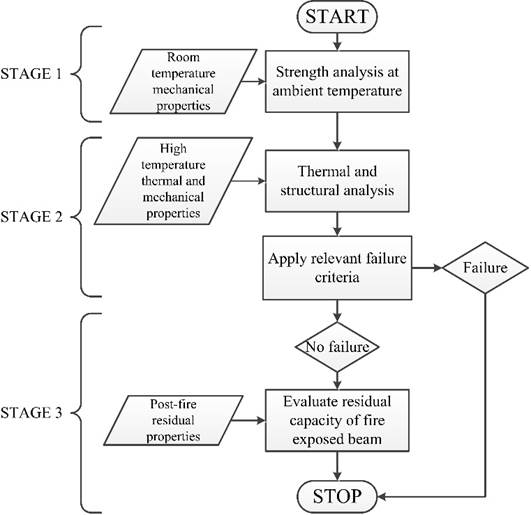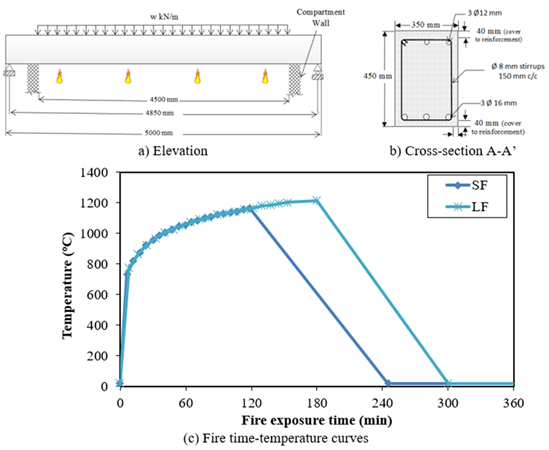| Basic Research | https://doi.org/10.21041/ra.v10i2.483 |
A numerical approach for evaluating residual capacity of fire damaged concrete members
Uma abordagem numérica para avaliar a capacidade residual de elementos de concreto submetidos a incêndio
Enfoque numérico para evaluar la capacidad residual de elementos de concreto sometidos a un incendio
V. K. R.
Kodur1
*
![]() , A. Agrawal1
, A. Agrawal1
![]()
1 Department of Civil Engineering, Michigan State University, East Lansing, USA..
*Contact author: kodur@egr.msu.edu
Reception:
October
16,
2019.
Acceptance:
February
05,
2020.
Publication: April 30, 2020.
| Cite as: Kodur, V. K. R., Agrawal, A. (2020), "A numerical approach for evaluating residual capacity of fire damaged concrete members", Revista ALCONPAT, 10 (2), pp. 230 – 242, DOI: http://dx.doi.org/10.21041/ra.v10i2.483 |
Abstract
This paper presents an approach to evaluate residual capacity of fire-damaged concrete structures. The approach involves capturing response in three stages; namely, structural response at ambient conditions (prior to fire exposure), thermo-mechanical response during fire exposure, and post-fire residual response after cooling down of the structural member. The proposed approach is implemented in a comprehensive numerical model developed in the finite element computer program ABAQUS for specifically evaluating residual capacity of an RC beam after exposure to different fire scenarios. Predictions from the numerical model are utilized to highlight importance of each stage of analysis in evaluating realistic residual capacity of fire damaged concrete members.
Keywords:
reinforced concrete members,
fire damage,
cooling phase,
post-fire residual capacity.
Resumo
Este artigo apresenta uma abordagem para avaliar a capacidade residual de estruturas de concreto danificadas pelo fogo. A abordagem envolve capturar a resposta em três fases; ou seja, resposta estrutural em condições ambiente (antes da exposição ao fogo), resposta termomecânica durante a exposição ao fogo e resposta residual pós-incêndio após o resfriamento do membro estrutural. A abordagem proposta é implementada em um modelo numérico abrangente desenvolvido no programa computacional ABAQUS de elementos finitos para avaliar especificamente a capacidade residual de uma viga de CA após exposição a diferentes cenários de incêndio. Previsões do modelo numérico são utilizados para destacar a importância de cada fase de análise em avaliar a capacidade residual real de elementos de concreto danificado pelo fogo.
Palavras-chave:
elementos de concreto armado,
danos por incêndio,
fase de resfriamento,
capacidade residual pós-incêndio
Resumen
Este artículo presenta un enfoque para evaluar la capacidad residual de estructuras de concreto deterioradas por el fuego. El enfoque implica capturar la respuesta entre las fases; es decir, respuesta estructural en condiciones ambiente (antes de la exposición al fuego), respuesta termo mecánica durante la exposición al fuego y respuesta residual incorporación-incendio, luego del enfriamiento del miembro estructural. El enfoque propuesto es implementado en un modelo numérico exhaustivo desarrollado en el programa computacional ABAQUS de elementos finitos para evaluar específicamente la capacidad residual de una viga de CA luego de la exposición a diferentes escenarios de incendio. Previsiones del modelo numérico son utilizadas para destacar la importancia de cada fase del análisis en evaluar la capacidad residual real de elementos de concreto dañados por el fuego.
Palabras clave:
elementos de concreto armado,
daños por incendio,
fase de enfriamiento,
capacidad residual incorporación-incendio.
1. Introduction
Fire represents a severe environmental condition that civil infrastructure may experience during their design life. Hence, structural members in buildings have to satisfy required fire resistance requirements specified in building codes (CEN, 2004a; ASTM Internacional, 2018). However, statistical data clearly suggests that while fires do occur in structures, complete collapse of structural systems due to fire is a rare event (Beitel and Iwankiw, 2005). The probability of complete collapse in reinforced concrete or pre-stressed concrete (RC and PC) structures is even lower due to low thermal conductivity, high thermal capacity, and slower degradation of mechanical properties of concrete with temperature (Tovey and Crook,1986; Kodur, 2014; Kodur, 2017). Therefore, it is reasonable to assume that concrete structures, after most fire incidents, can be opened to re-occupancy with adequate repair and retrofitting (Kodur and Agrawal, 2015; Kodur and Afrawal, 2016; Kodur and Phan, 2007).
Nonetheless, there is always uncertainty regarding level of remaining structural capacity in concrete members following a fire incident. It is imperative to assess if sufficient residual capacity exists in structural members prior to re-occupancy following a severe fire. Also, such an assessment forms the basis for developing relevant retrofitting (repair) strategies in fire-damaged concrete structures.
Residual capacity retained in fire damaged concrete structures is highly variable and depends on both temperature history as well as structural conditions present during fire exposure (Kodur and Agrawal, 2015; Kodur and Afrawal, 2016; Kodur and Phan, 2007). Number of factors, including fire severity, temperature dependent material properties of rebar and concrete, duration of fire (heating and cooling periods), temperature induced bond degradation, load level, and restraint conditions present during fire exposure influence residual capacity. Many of these factors are interdependent and can vary significantly in different scenarios. Thus, evaluation of residual capacity can be quiet complex and depends on the assumptions used in analysis.
At present, there are limited approaches for residual capacity assessment of fire-damaged concrete structures (Bai and Wang, 2011; Kodur et al, 2013; Kodur et al, 2010). Majority of these approaches are based on sectional analysis which do not account for relevant load level, boundary conditions, and post-fire residual deformations in evaluating residual capacity. Also, most of the current residual capacity evaluation approaches do not account for strain hardening effect in reinforcement, which can lead to under-prediction of moment capacity by 15-25% than the actual value experienced in field applications (Kodur and Agrawal, 2016).
To overcome some of the above drawbacks, an approach is proposed for predicting residual capacity and residual deflections of fire exposed RC structures. The novelty of the current approach lies in the consideration of distinct material properties of reinforcing steel and concrete during heating phase of fire exposure, cooling phase of fire exposure, as well as residual phase (after cool down), and in incorporating post-fire residual (plastic) deformations of fire damaged RC members into post-fire response analysis. The proposed approach is implemented through in a comprehensive numerical model developed in a finite element based computer program ABAQUS (ABAQUS, 2012). Results from numerical studies are utilized to illustrate the significance of each stage of analysis in evaluating residual capacity of fire damaged RC members.
2. Fire damage in concrete structures
The extent of damage to concrete structures due to fire exposure is influenced by conditions existing just prior to the fire incident, as well as during complete fire exposure duration, including extended cooling phase when cross-sectional temperatures in the member reverts back to ambient conditions. The different phases encountered for a typical RC beam during and after a fire are illustrated in Fig. 1. Once the fire attains flashover, cross-sectional temperatures increase, and load carrying capacity decreases, together with rise in deflection due to temperature induced degradation in strength and stiffness of concrete and rebar. Furthermore, even as fire temperatures begin to decay during cooling phase, cross-sectional temperatures within the structural member remain significantly high for prolonged duration following burnout conditions or after fire is extinguished, owing to high thermal inertia of concrete. In fact, temperatures within the member may not cooldown to ambient conditions until 24 to 72 hours after fire has been extinguished, depending on size (thermal mass) of the member and fire severity. After the member cools down to ambient conditions, an unrecoverable deflection exists in the structural member. These residual deformations represent the state of structural damage in the member resulting from fire exposure and the extent of damage depending on load level, boundary conditions, and temperature induced degradation in material properties.
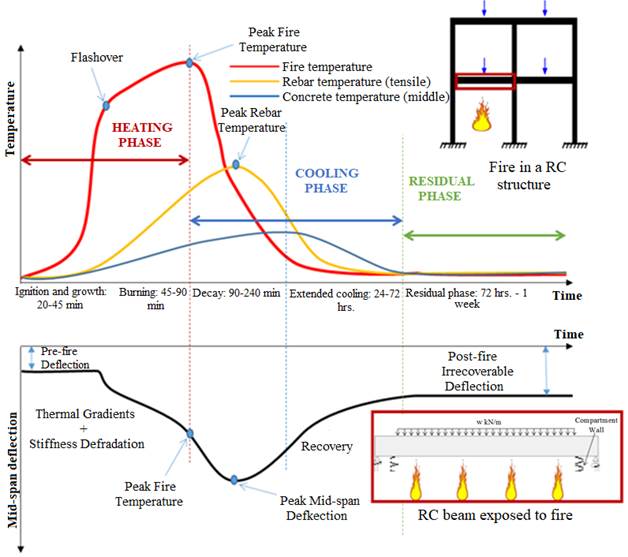
Figure 1.
Response of a typical RC beam during and after fire exposure.
Thus, it is crucial to establish sectional temperatures experienced by the structural member, structural conditions present during the fire event, rate of cooling, and residual deformations to assess residual capacity of fire damaged concrete members.
3. Approach for evaluating residual capacity
The behavior of a RC member after fire exposure generally depends on parameters such as load level, temperatures experienced within the member during fire exposure, the rate of cooling and strength recovery after fire. A general approach comprising of three stages, which incorporate the interdependency of these parameters in evaluating residual capacity of RC members, is presented in this section.
3.1 General procedure
For evaluating residual capacity, strength analysis of an RC member has to be carried out in three stages, namely, ambient response analysis at room temperature (Stage 1), elevated temperature analysis comprising of both heating and cooling phase of fire exposure (Stage 2) and finally, post-fire residual analysis after cooling down of the concrete member (Stage 3). The three stages of the analysis for evaluating residual capacity of fire damaged RC members are illustrated through a flow chart in Fig. 2. This type of approach can be applied through advanced analysis by utilizing commercial finite element software package such as ABAQUS (ABAQUS, 2012).
In Stage 1, load (moment) carrying capacity of an RC member is evaluated through specified strength equations for room temperature capacity evaluation available in design standards. Alternatively, detailed finite element analysis can be carried out by gradually incrementing the load on the member till failure occurs. For this analysis, room temperature strength and stiffness properties of concrete and reinforcing steel are to be taken into consideration.
In Stage 2 of analysis, the response of RC member is evaluated under a given fire scenario, load level, and restraint conditions that are present during fire exposure. Both thermal and structural response of the member is traced to evaluate the fire performance of the RC member. In this stage, temperature dependent properties of concrete and reinforcing steel specific to heating and cooling phase of fire are to be input (Kodur and Agrawal, 2015; Kodur and Afrawal, 2016; Kodur and Phan, 2007). This stage of the analysis is carried out at various time increments till the failure of the member, or through total duration of fire exposure, whichever comes first. Response parameters from the thermal and structural analysis are to be utilized to check failure at the end of each time increment to evaluate the state of the RC member under different failure limit states.
Following the cooling down of the member, if there is no failure in Stage 2; Stage 3 of analysis is to be carried out. In this stage of the analysis, the RC member is loaded incrementally, and the structural response of the member is traced. For this analysis, specific residual properties of material (concrete and steel reinforcement) are considered. The load increments continue until the member fails as per any of the specified limit states governing failure.
4. Case study
In order to illustrate the capability of the proposed approach for evaluating the residual strength of a fire exposed RC member, a finite element model was developed in ABAQUS (ABAQUS, 2012). This model was applied to evaluate response of fire damaged RC beams at three different stages of analysis as per the proposed approach. Full details of and validation of the proposed approach for residual capacity analysis of residual capacity evaluation of fire damaged concrete members can be found elsewhere (Kodur and Agrawal, 2016).
4.1 Beams analyzed
Two identical concrete beams, designated as beams B1 and B2, were analyzed for residual capacity after exposure to fire scenarios with distinct heating and cooling phases. Key response parameters including deflections and temperatures were calculated during different stages of analysis to monitor performance of each beam. The analysis parameters assumed for the two beams are summarized in Table 1.
Table 1. Summary of analysis parameters and results used for case study.
Beam designation
Support Condition
Fire exposure
ACI design capacity (kN-m)
Predicted fire resistance (min)
Predicted residual capacity (kN-m)
B1
Simply supported
SF*
191
No Failure
189
B2
LF**
No Failure
164
*Short fire scenario with 2h heating phase; **Severe fire scenario with 3h heating phase
4.2 Analysis details
The analysis was carried out using the finite element computer program ABAQUS (ABAQUS, 2012). The constitutive models for concrete and steel are defined within the framework of the software package and the modeling of fire exposed RC beams is undertaken using sequentially coupled thermo-mechanical analysis procedure. In this procedure, the mechanical analysis utilizes the results (temperatures) generated in the heat transfer analysis, but no reverse dependency exists. Furthermore, two sub-models are needed to carry out the three stages of analysis, namely, structural and thermal models. A structural model is needed to carry out strength analysis in Stages 1, 2, and 3, while Stage 2 of analysis requires heat transfer calculations to compute sectional temperatures in the RC beam.
In the case of structural model, eight-noded continuum elements with reduced integration (C3D8R) and two-node link elements (T3D2) are utilized for discretization of concrete and reinforcing steel respectively. In the case of thermal model in 3D space, concrete and reinforcement were discretized using DC3D8 elements (8 noded linear brick element) and DC1D2 elements (2 noded link element) available in ABAQUS (ABAQUS, 2012) library, having nodal temperature (NT11) as the only active degree of freedom.
4.3 Input parameters for analysis
Various input parameters such as model geometry, load distribution, boundary conditions, fire scenarios and material properties are required to carry out different stages of analysis. The details of the beams and the time-temperature curves of the fire scenarios assumed for analysis are presented schematically in Fig. 3a-c.
Both beams had identical cross-sectional dimensions and reinforcement details. The steel of the main reinforcing bars and stirrups was assumed to have yield strengths of 450 MPa and 280 MPa, respectively. Also, the average compressive (cylinder) strength of concrete was assumed to be 50 MPa. The beams were assumed to be simply supported for all stages of analysis. A uniformly distributed load was applied on each beam generating a bending moment of 50% of the beam capacity according ACI 318 (American Concrete Institute, 2008), similar to load (stress) level typically present during pre-fire exposure conditions. The fire exposure scenarios adopted to simulate fire damage in the beams were calculated as per Eurocode 1 (CEN, 2004a) and comprised of a distinct heating and cooling phase. Varying the fuel load from 500 MJ/m2 to 750 MJ/m2 resulted in heating phase duration of 2h for the Short Fire (SF) scenario, and 3h for Severe Fire (LF) scenario respectively. Linear cooling (decay) in fire temperatures was adopted as per Eurocode 1 (CEN, 2004a) recommendations to simulate cooling phase in the structural member (see Fig. 3).
Besides these input parameters, various material properties are to be input during different stages of analysis as well. For Stage 1 analysis, at room temperature, typical uniaxial stress-strain relations for concrete and steel at room temperature are adopted. In Stage 2 of analysis, during heating phase, the temperature dependent thermal and mechanical properties of reinforcing steel and concrete are assumed to follow as that of Eurocode 2 and 3 provisions (CEN, 2004b; CEN, 2004d). In Stage 3 of analysis, after cooling of the fire exposed RC beam, the residual uniaxial compressive and tensile strength of concrete after cooling down to room temperature is assumed to be 10% less than the strength attained at the maximum temperature. This assumption is based on Eurocode 4 (CEN, 2004e) recommendations. The residual stress-strain relation for reinforcing steel is calculated using degradation observed by Neves et al. (1996).
4.4 Output results
Displacement and temperature fields are the primary output variables that are generated during different stages of analysis. Displacements due to applied loading in the first stage of analysis are used to ascertain condition of the beam during Stage 1 of analysis. In Stage 2 of analysis, the output from the thermal analysis, namely nodal temperatures, is applied as a thermal body load on the structural model to evaluate the mechanical response of RC beam under fire exposure. An identifier to ascertain if the material is under heating or cooling phase, so as to apply the appropriate material properties, is updated in the structural analysis using subroutine UFIELD available in ABAQUS (ABAQUS, 2012). Also, the maximum temperatures experienced at each node during thermal analysis are used to calculate residual mechanical properties to be used for the residual capacity evaluation in Stage 3 of analysis, when necessary. The load (moment)-deflection response from Stage 3 of the analysis is utilized to evaluate residual capacity of fire exposed reinforced concrete beams.
5. Results and discussion
In Stage 1 of analysis, the room temperature design capacity of beams B1 and B2 were calculated to be 191 kN-m as per ACI 318 (ACI, 2008) design equations. In addition, the realistic room temperature capacity of the RC beams prior to fire exposure, using finite element analysis when strain hardening and no material reduction factor is applied, was calculated to be 250 kN-m.
After evaluating room temperature capacity in Stage 1, each beam was subjected to distinct fire exposure scenario under constant load (stress) level in Stage 2 of analysis. During Stage 2 of analysis (fire exposure), thermal and structural response of the beams was evaluated not only till the end of fire exposure, but over an extending cooling period i.e. period covering between fire being extinguished to complete cooling down, which included time taken for the entire cross-section of the beam to revert back to room temperature.
The thermal response of the analyzed beams, B1 and B2, during fire exposure is shown in Fig. 4 by plotting rebar and concrete temperatures at different locations in the cross section, as a function of time. Unlike fire temperatures that rose rapidly in the first few minutes, the temperatures within the cross section of both beams started to rise at about 10 to 15 minutes into fire exposure, when fire temperatures were already in excess of 700°C. Temperatures within the beam cross-section rise monotonically during heating phase of beams B1 and B2, which last for 120 minutes and 180 minutes respectively.
Furthermore, cross-sectional temperatures in both beams continue to increase even as fire temperatures decay, owing to high thermal inertia of concrete. In fact, cross-sectional temperatures reach peak values during cooling (decay) phase of fire exposure in both beams. Peak rebar temperatures in B1 and B2 are calculated to be 592°C and 715°C at 170 min and 240 min respectively, well after heating phase of fire exposure has ended. Similarly, peak temperatures at concrete mid-depth are calculated to be 240°C and 315°C respectively. Therefore, the relatively less severe fire exposure adopted for beam B1 leads to relatively lower cross-sectional temperatures as compared to those experienced in beam B2. Nonetheless, both beams do not fail during fire exposure or during extended cooling phase after fire exposure.
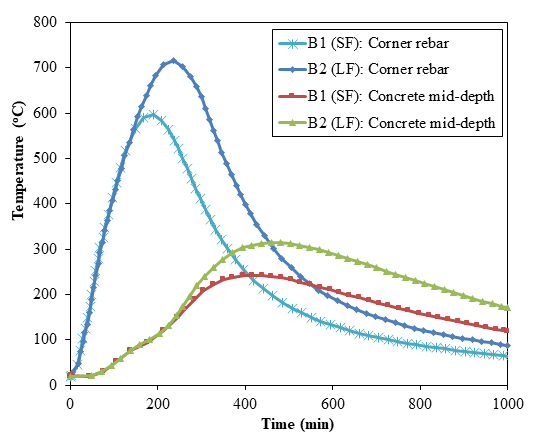
Figure 4.
Predicted temperatures in beams B1 and B2
The structural response of beams B1 and B2 can be gauged through predicted mid-span deflections as a function of time as plotted in Fig. 5. During this early stage of fire exposure, deflection rise is mainly governed by level of applied loading and thermal gradients that develop within the beam cross-section. As fire exposure progresses further, cross-sectional temperature within the beam begin to rise and thermal gradients decrease along the depth. Mid-span deflection in beams continues to increase, but at a relatively gradual rate, owing to gradual reduction in mechanical properties, especially elastic modulus of reinforcing steel.
As the rebar temperatures continue to increase steadily, peak mid-span deflection was calculated to be approximately 80 mm and 120 mm in beams B1 and B2 respectively. It can be seen that as peak rebar temperature increased from approximately 600oC to 700oC, peak mid-span deflection increased significantly by almost 50%.
Both beams do not fail during fire exposure and mid-span deflections recover once the rebar and concrete temperatures revert back to ambient temperatures. This can be primarily attributed to the recovery in strength and modulus properties in reinforcing steel, once the beam enters the extended cooling phase. Also, recovery in mid-span deflection during the cooling phase of fire exposure is governed by cross-sectional temperatures, especially rebar temperatures.
A steady state mid-span deflection is attained in both beams B1 and B2 as rebar temperatures cool down below 150oC. In addition, noticeable residual deformation is left over in the fire exposed beams and it does not revert back to its pre-fire configuration after applied loading is removed. This is primarily due to irreversible temperature induced damage in concrete, which does not recover any of its strength and stiffness properties upon cool down to ambient conditions, as well as residual plastic strains in steel reinforcement and concrete even after cooling down to room temperature. Such deformations adversely affect future serviceability of the fire damaged concrete structure, as these deformations are significantly larger than pre-fire (room temperature) deflection in the member. The residual deformation, with no load acting on the beam, was calculated to be 43 mm for beam B1 and 74 mm for beam B2 respectively (see Fig. 6), and this was assumed to be the initial state for the residual strength analysis in Stage 3.
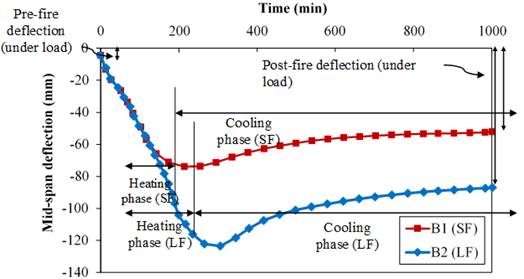
Figure 5.
Predicted mid-span deflections during fire exposure in beams B1 and B2
The residual moment-deflection response of beams B1 and B2 is evaluated in Stage 3 of analysis and shown in Fig. 6. Both fire damaged beams exhibit three key phases in deflection progression i.e., linear response (marked as A-B in Fig. 6), onset of yielding in steel reinforcement (marked as B in Fig. 6), and plastic deformation until failure (marked as B-C in Fig. 6). In the first phase (see A-B in Fig. 6), moment-deflection response of fire damaged beams follows a linear trend as seen in a cracked section, until the onset of yielding in steel reinforcement. This can be attributed to extensive tensile cracking and temperature induced material degradation that occur in the beams during fire exposure. The yielding moment for fire damaged beams B1 and B2 was calculated to be 135 kN-m and 150 kN-m respectively.
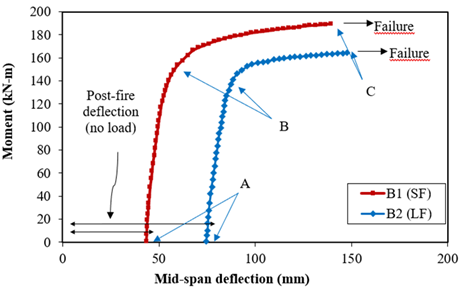
Figure 6.
Predicted residual moment-deflection response for fire damaged beams.
Following yielding, the beams deforms in a plastic fashion with further increase in moment carrying capacity due to strain hardening effect in steel reinforcement.
The peak moment-carrying capacity in fire damaged beams B1 and B2 was calculated to be 189 kN-m and 164 kN-m respectively. This calculated residual capacity was comparable to room temperature capacity computed as per ACI 318 (ACI, 2008) even after significant fire damage since strain hardening of steel is conservatively not accounted for in ACI 318 (ACI, 2008) design equations for estimating capacity of beam in Stage 1 (Kodur et al., 2010). However, the residual capacity of beams B1 and B2 represents a recovery of 76% and 65% respectively, with respect to realistic room temperature capacity of the beam calculated using finite element analysis. Thus, following a fire incident, fire damaged beams may satisfy design limit state from strength consideration but need to be retrofitted to provide comparable level of safety (capacity) which existed prior to the fire incident.
6. Conclusion
A general approach for evaluating residual capacity of fire exposed RC structural members is proposed. Based on the results of analysis the following conclusions can be drawn:
Following a fire incident, fire damaged beams may satisfy design limit state from strength consideration but need to be retrofitted to provide comparable level of safety (capacity) which existed prior to the fire incident.
7. Acknowledgements
The authors wish to acknowledge the support of United States Agency for International Development (through Pakistan-US Science and Technology Cooperative Program grant PGA-2000003665) and Michigan State University for undertaking this research. Any opinions, findings, conclusions, or recommendations expressed in this paper are those of the author and do not necessarily reflect the views of the institution.
References
ABAQUS (2012), ABAQUS Version 6.12 Documentation. Dassault Systemes Simulia Corp., Providence, RI. URL: http://130.149.89.49:2080/v6.12/index.html
American Concrete Institute (ACI) (2008). ACI 318-08: Building code requirements for reinforced concrete. Vol. 552. American Concrete Institute. 465 pp. Farmington Hills, MI.
ASTM International (2018). E119-18 Standard Test Methods for Fire Tests of Building Construction and Materials. West Conshohocken, PA; ASTM International. doi: https://doi.org/10.1520/E0119-18
Bai, L., Wang, Z. (2011). Residual Bearing Capacity of Reinforced Concrete Member after Exposure to High Temperature. Advanced Materials Research. 368-373:577-81. https://doi:10.4028/www.scientific.net/AMR.368-373.577 .
Beitel J., Iwankiw N. (2005). Historical Survey of Multistory Building Collapses Due to Fire. Fire Protection Engineering. 3rd Quart. issue 27: 42-49.
European Committee for Standardization (CEN) (2004a). EN 1991-1-2, Eurocode 1: Actions on structures. Part 1-2: General actions - Actions on structures exposed to fire. Brussels, Belgium.
European Committee for Standardization (CEN) (2004b). EN 1992-1-1, Eurocode 2: Design of concrete structures. Part 1-1: General rules and rules for buildings. Brussels, Belgium; 2004.
European Committee for Standardization (CEN) (2004c). EN 1992-1-2, Eurocode 2: Design of Concrete Structures. Part 1-2: General Rules - Structural Fire Design, p. 97. Brussels, Belgium.
European Committee for Standardization (CEN) (2004d). EN 1993-1-2, Eurocode 3: Design of steel structures. Part 1-2: General rules-structural fire design. Brussels, Belgium; 2004.
European Committee for Standardization (CEN) (2004e). EN 1994-1-2, Eurocode 4: Design of composite steel and concrete structures. Part 1-2: General rules-structural fire design. Brussels, Belgium; 2004.
Kodur, V. (2014). Properties of concrete at elevated temperatures. International Scholarly Research Notices Civil Engineering. 2014 (ID 468510): 1-15. https://doi.org/10.1155/2014/468510
Kodur, V., Hibner, D., Agrawal, A. (2017). Residual response of reinforced concrete columns exposed to design fires. Procedia Engineering. 210: 574-81. https://doi.org/10.1016/j.proeng.2017.11.116.
Kodur, V. K., Agrawal, A. (2015). Critical Factors Governing the Residual Response of Reinforced Concrete Beams Exposed to Fire. Fire Technology. 52(4): 967 pp. ISSN: 0015-2684 eISSN: 1572-8099. Springer US. https://doi.org/10.1007/s10694-015-0527-5.
Kodur, V. K. R., Agrawal, A. (2016) An approach for evaluating residual capacity of reinforced concrete beams exposed to fire. Engineering Structures. 110:293-306. https://doi.org/10.1016/j.engstruct.2015.11.047.
Kodur, V. K. R., Dwaikat, M. B., Fike, R.S. (2010). An approach for evaluating the residual strength of fire-exposed RC beams. Magazine of Concrete Research. 62 (7): 479-88. ISSN: 0024-9831, eISSN: 1751-763X. https://doi.org/10.1680/macr.2010.62.7.479.
Kodur, V. K. R., Phan, L. (2007). Critical factors governing the fire performance of high strength concrete systems. Fire Safety Journal. 42 (6-7): 482-488. ISSN: 0379-7112. https://doi.org/10.1016/j.firesaf.2006.10.006.
Kodur, V. K. R., Raut, N. K., Mao, X. Y. (2013). Khaliq W. Simplified approach for evaluating residual strength of fire-exposed reinforced concrete columns. Materials and Structures. 46:2059-2075. https://doi:10.1617/s11527-013-0036-2.
Neves, I., Rodrigues, J. P. C., Loureiro, A. D. P. (1996). Mechanical properties of reinforcing and prestressing steels after heating. Journal of Materials in Civil Engineering 8. (4):189-194. https://doi.org/10.1061/(ASCE)0899-1561(1996)8:4(189)
Tovey, A. K., Crook, R. N. (1986). Experience of Fires in Concrete Structures. in SP-092: Evaluation and Repair of Fire Damage to Concrete. Special Publication. 92:1-14. American Concrete Institute.

